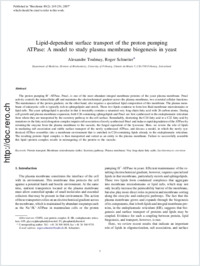Lipid-dependent surface transport of the proton pumping ATPase: A model to study plasma membrane biogenesis in yeast
- Toulmay, Alexandre Department of Medicine, Division of Biochemistry, University of Fribourg, Switzerland
- Schneiter, Roger Department of Medicine, Division of Biochemistry, University of Fribourg, Switzerland
-
15.08.2006
Published in:
- Biochimie. - 2007, vol. 89, no. 2, p. 249-254
protein transport
membrane microdomains (rafts)
secretory pathway
plasma membrane
very long-chain fatty acids
Saccharomyces cerevisiae
English
The proton pumping H+-ATPase, Pma1, is one of the most abundant integral membrane proteins of the yeast plasma membrane. Pma1 activity controls the intracellular pH and maintains the electrochemical gradient across the plasma membrane, two essential cellular functions. The maintenance of the proton gradient, on the other hand, also requires a specialized lipid composition of this membrane. The plasma membrane of eukaryotic cells is typically rich in sphingolipids and sterols. These two lipids condense to form less fluid membrane microdomains or lipid rafts. The yeast sphingolipid is peculiar in that it invariably contains a saturated very long-chain fatty acid with 26 carbon atoms. During cell growth and plasma membrane expansion, both C26-containing sphingolipids and Pma1 are first synthesized in the endoplasmatic reticulum from where they are transported by the secretory pathway to the cell surface. Remarkably, shortening the C26 fatty acid to a C22 fatty acid by mutations in the fatty acid elongation complex impairs raft association of newly synthesized Pma1 and induces rapid degradation of the ATPase by rerouting the enzyme from the plasma membrane to the vacuole, the fungal equivalent of the lysosome. Here, we review the role of lipids in mediating raft association and stable surface transport of the newly synthesized ATPase, and discuss a model, in which the newly synthesized ATPase assembles into a membrane environment that is enriched in C26-containing lipids already in the endoplasmatic reticulum. The resulting protein–lipid complex is then transported and sorted as an entity to the plasma membrane. Failure to successfully assemble this lipid–protein complex results in mistargeting of the protein to the vacuole.
- Faculty
- Faculté des sciences et de médecine
- Department
- Département de Biologie
- Language
-
- English
- Classification
- Medicine
- License
-
License undefined
- Identifiers
-
- RERO DOC 7854
- DOI 10.1016/j.biochi.2006.07.020
- Persistent URL
- https://folia.unifr.ch/unifr/documents/300372
Statistics
Document views: 125
File downloads:
- pdf: 223
